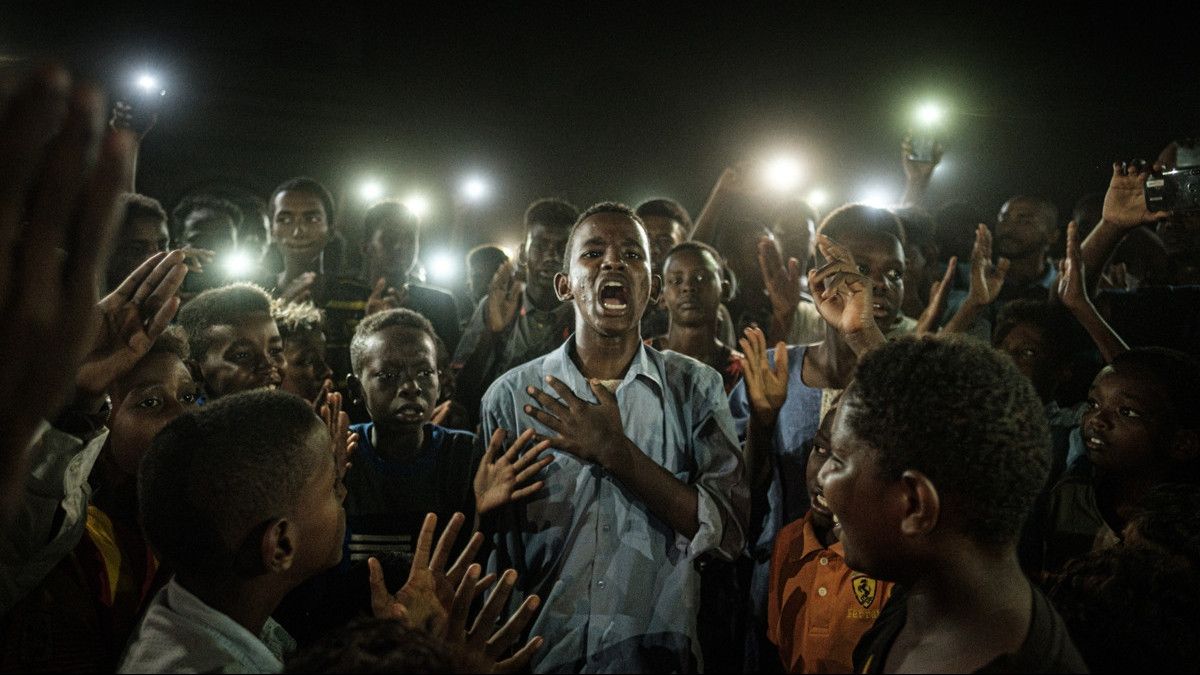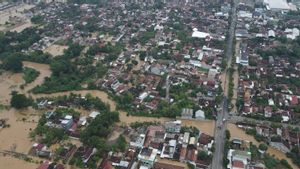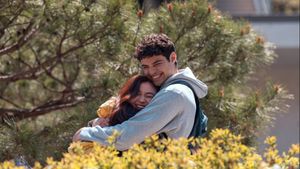JAKARTA - A young man puts his left hand on his chest. His mouth is wide open. Around him, there were a number of people who illuminated him with light from their cell phones. The photo captured by AFP photographer Yasuyoshi Chiba is indeed everything. A photo worthy of the most prestigious award in this year's photojournalism work, World Press Photo of the Year 2020.
In the real dimension, the chanting of poetry comes out of the man's mouth. In the midst of the darkness, light-carrying hands accompany the poem with shouts of protest to the government. Sudan has indeed been heating up since 2018. Protests after protests were launched. That day, 19 June 2019, demonstrations took place amid a blackout in Khartoum, the capital of Sudan.
The wave of protests in Sudan started in December 2018. Since then, demonstrations have spread rapidly across the country. April 2019, demonstrators staged a protest near the army headquarters in Khartoum. The mass sit-in was carried out to demand the resignation of President Omar al-Bashir, who has been in charge for 30 years.
On April 11, 2019, al Bashir was removed from office in a military coup. A transitional government controlled by the military was established. However, the protests continued. The people want power to be handed over to civilian groups.
The atmosphere got even more chaotic. On 3 June 2019, government forces opened fire on unarmed demonstrators. Dozens of people were killed that day. A day that marks the gloom of upholding human rights (HAM) in Sudan. Because, since that day, various acts of violence by the authorities have continued against community groups.
Three days after the brutal shooting, the African Union suspended Sudan amid intense international criticism of the attack. Since then, authorities have taken various measures to quell the protests, including turning off electricity and turning off the internet.
Society keeps moving. Demonstrators have been communicating via text messages ever since. A chain of word of mouth was established. Unfortunately for the authorities, because the resistance did not subside. Finally, on 17 August 2019 the pro-democracy movement succeeded in winning a solution in the form of a power-sharing agreement between the military and civilian groups.
Yasuyoshi Chiba
Yasuyoshi Chiba is not a foreign name among photojournalism lovers. The first award for the World Press Photo photo contest was in 2009.
At that time, the clash between the Maasai Warriors and the Kalenjin Tribe captured by Yasuyoshi won the award for the People in the News Category. Furthermore, in 2012, a photo of Yasuyoshi's story about the tsunami on Tohoku Beach, Northeast Japan also won an award for the People in the News Category.

Yasuyoshi is AFP's Chief Photographer for East Africa and Indian Ocean based in Nairobi, Kenya. Yasuyoshi studied photography at the Mushashino Art University in Tokyo.
He started his career as a photographer at the Asahi Shimbun, a Japanese newspaper based in Osaka. After that, he became a freelance photographer and moved to Kenya in 2007, before joining AFP in Brazil in 2011.
Another work
What better way to reflect back on the events that the world has gone through than through a single reflection of light and a mirror? And the World Press Photo Contest, for a long time, is the most comprehensive gallery from which to see the world.
In addition to Yasuyoshi's Sudan demonstration, World Press Photo 2020 also features major events in other worlds. In the 2020 World Press Photo Category, Yasuyoshi's works are side by side with those of Farouk Batiche and Ivor Prickett, who both frame a major protest event in Algeria, North Africa.
In addition, there is also a photo of the relatives of the Ethiopian Airlines ET302 victim who had an accident on March 10, 2019. The accident killed 157 people. The severity of the impact of the plane even sank the two Boeing 737 MAX aircraft engines into a crater up to 10 meters.
In another category, French photographer Romain Laurendeau won the World Press Photo Story of the Year with an image that happened in Algeria throughout 2018 to 2019. Algeria is indeed plagued by so many problems. Laurendeau framed one of them, namely the issue of the troubled lives of young Algerians.
In Algeria, youth dominate more than half of the population in Algeria. According to the UNESCO report, 72 percent of young people or those under the age of 30 are unemployed. This fact brings back the dark history of the country, namely the 'Black October' rebellion in 1988.
In Black October, more than five hundred people died in a span of five days. Those five days then stretched out to create a gloomy decade across the country. Various violence and riots colored Algeria during that time.
Thirty years later, this traumatized and frustrated country is back in turmoil. High unemployment creates tremendous anxiety. The relationship between the state and its youth seems cut off. Non-renewable state institutions. Operating companies are unable to absorb them.
Football, for many young men, is both an identity and a means of escape. The rest of the group was involved in the protest activities. Quasi-political fan groups known as 'Ultras' played a big role in the protests.
Another group, the neglected working class. In recent years, these youth groups have merged into a single movement that has undermined President Abdelaziz Bouteflika's government, which is considered to have failed to meet various national challenges.
You can see a gallery of world reflections that have been framed by world photographers in recent years here .
The English, Chinese, Japanese, Arabic, and French versions are automatically generated by the AI. So there may still be inaccuracies in translating, please always see Indonesian as our main language. (system supported by DigitalSiber.id)













